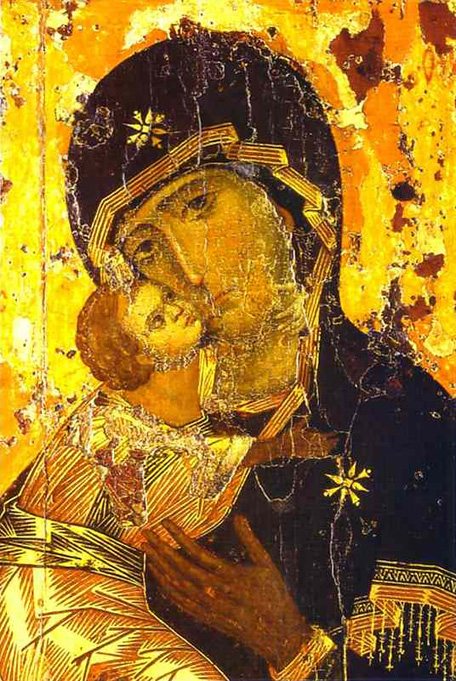The Renaissance was a reaction to medieval pessimism about the human condition. Petrarch, Mirandola, and other early humanists celebrated the dignity of man because western culture, despite deep roots in the anthropological optimism of traditional Christianity, had for centuries come to diminish the human experience of paradise in this world. Having explored this reaction in light of eastern Christendom, I would now like to turn to one of the most famous elements of the Renaissance, its art.
In this and a few subsequent posts, I would like especially to bring attention to Renaissance painting. For cultural historians such as Burckhardt, this was the ultimate expression of a renewed optimism that would inspire western Christendom for centuries to come.
A good painting to start with is the Madonna of the Pinks by Raphael (d. 1520). It provides a stark example of the new orientation of modern art toward the natural, spiritually untransformed world. It is an example of modern Christendom’s incipient secularization.
The art of traditional Christendom prior to the Renaissance had been liturgical, that is, it had served as a means toward the spiritual end of worship. A painting of the Virgin Mary such as the Vladimir Icon of the Mother of God (imported from Byzantium into Russia during the twelfth century) was designed to bring the believer, presumably standing before the work of art in a temple, into a fuller experience of communion with God.  Grounded in traditional Christianity’s proclamation of the incarnation–that God became man and entered into this world–Christian iconography oriented man beyond this world toward the kingdom of heaven. Yet it did so by asserting that the kingdom is present in this world and has transfigured it through the divine-human experience of true worship.
Grounded in traditional Christianity’s proclamation of the incarnation–that God became man and entered into this world–Christian iconography oriented man beyond this world toward the kingdom of heaven. Yet it did so by asserting that the kingdom is present in this world and has transfigured it through the divine-human experience of true worship.
With Raphael, the art of Christendom becomes disoriented. It begins to point only toward this world. In doing so, it ceases to be liturgical and becomes merely religious. And from there it would inevitably become secular.
The natural, worldly beauty of the Madonna of the Pinks is magnificent on its own terms.

Full title: The Madonna of the Pinks (‘La Madonna dei Garofani’) Artist: Raphael Date made: about 1506-7 Source: http://www.nationalgalleryimages.co.uk/ Contact: picture.library@nationalgallery.co.uk Copyright © The National Gallery, London
And yet its contrast to the liturgical arts of traditional Christianity is equally impressive. Gone is a liturgical encounter with the Mother of God, presenting her son to his worshipers. (In the Vladimir Icon and others of the Byzantine “hodegetria” type, she actually gestures with her hand toward Christ as if to say, “don’t look at me, look at him”). This is a painting of a lovely, charming young woman caught in a moment of domestic playfulness. Gone is her modest dress, her dark clothing and veil. Gone, or almost gone, is her halo.
But most striking here is the image of Christ. He is no longer the incarnate Son of God, the creator of this world and its almighty savior. He is now a cute, kissable, but apparently powerless complement to his adoring mother. And he is naked. Nothing reveals the coming secularization of modern Christendom so expressively as the naked “Baby Jesus” that emerges from the Madonnas of Raphael and other western painters at this time. Prayer before such an image has become virtually impossible, at least by the standards of traditional Christianity.
Liturgical art, pointing beyond this world to a divine communion that has broken into it, now gives way to a secular art for its own sake, reorienting the viewer toward a world that operates for its own sake.
What can then be said about icons like the Theotokos of Valaam? Although it leans towards naturalism it still retains an iconographic quality with the appropriate gestures, postures and details, unlike The Madonna of the Pinks. What balance should be struck between naturalism and abstraction? I speak of a balance, not a line to be drawn, because I do not want to suggest a false, almost gnostic, dichotomy of the spiritual and material. After all, people in icons resemble people in nature.
Also, thank you for your podcasts on AFR! I have learned a great deal.
LikeLike
Pingback: What Child is This?, or, on the Rise of “Baby Jesus” | PARADISE AND UTOPIA